The Clinical Refractometer Market is estimated to be valued at USD 800.0 million in 2025 and is projected to reach USD 1,569.3 million by 2035, registering a compound annual growth rate (CAGR) of 7.0% over the forecast period.
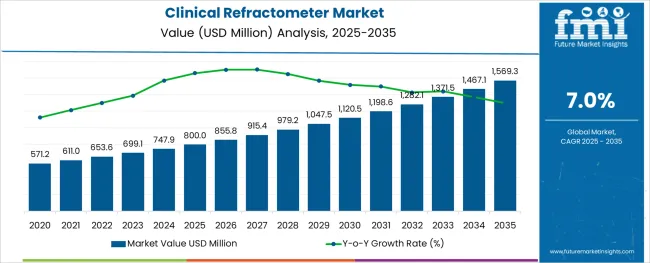
The clinical refractometer market is advancing steadily as demand increases for precise and reliable measurement tools in clinical and research settings. The growing emphasis on accurate diagnostics and laboratory quality control has elevated the importance of refractometers in assessing sample properties such as concentration and purity. Advances in technology have enabled the production of devices that are more user-friendly and precise, which appeals to healthcare and academic laboratories.
Expansion in healthcare infrastructure and increased funding for academic research have contributed to higher adoption rates. Additionally, the rise in chronic diseases and the need for better diagnostic tools have supported market growth.
Future opportunities lie in the integration of refractometers with digital data management systems and portable device development. Segment growth is anticipated to be driven by analog refractometers in product type and academic laboratories as the leading end-use segment.
The market is segmented by Product Type and End Use and region. By Product Type, the market is divided into Analog Refractometers, Digital Handheld Refractometer, Bench-Top Refractometers, Abbe Refractometers, and Portable Refractometers. In terms of End Use, the market is classified into Academic Laboratories, R&D Laboratories, and Others. Regionally, the market is classified into North America, Latin America, Western Europe, Eastern Europe, Balkan & Baltic Countries, Russia & Belarus, Central Asia, East Asia, South Asia & Pacific, and the Middle East & Africa.
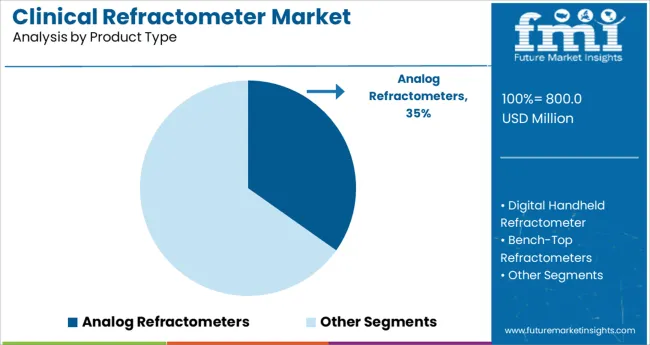
The Analog Refractometers segment is projected to contribute 34.8% of the clinical refractometer market revenue in 2025, maintaining its position as a key product type. This segment has grown due to the devices’ simplicity, cost-effectiveness, and reliability in routine clinical measurements. Analog refractometers offer straightforward operation and do not require extensive calibration, making them preferred in many laboratories with budget constraints.
Their portability and ease of maintenance further support their use in varied clinical environments. While digital refractometers are gaining traction, analog models continue to be favored where ease of use and durability are priorities.
The Analog Refractometers segment is expected to sustain its role by serving both primary and specialized laboratory needs.
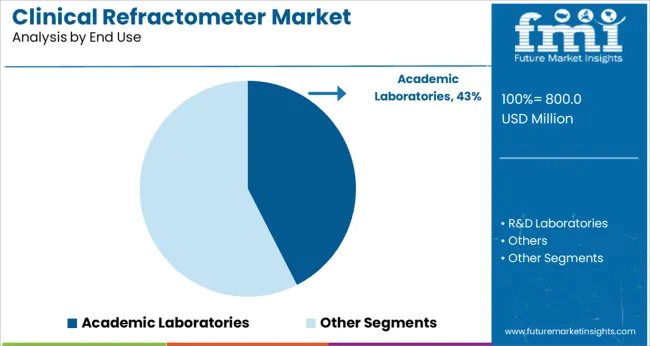
The Academic Laboratories segment is projected to hold 42.5% of the clinical refractometer market revenue in 2025, leading all end-use categories. Growth in this segment has been fueled by the integral role refractometers play in teaching, research, and quality control within educational and research institutions.
Academic labs require precise measurement tools for experiments involving solutions, chemical concentrations, and biological samples. The focus on developing scientific expertise and expanding research activities has increased demand for refractometers in these environments.
Academic institutions tend to invest in a mix of analog and digital refractometers to balance cost and functionality. The Academic Laboratories segment is expected to remain dominant due to ongoing research funding and the critical role refractometers play in scientific education.
Growing focus on automation in various industries such as food & beverages, healthcare, industrial, and others will drive the demand for clinical refractometers. They are increasingly used to measure the refractive index, sugar content, alcohol level, and gravity of body fluids such as serum, blood plasma, and others.
Application of portable and digital refractometers in food & beverage, healthcare, and industrial sectors will boost the clinical refractometer market. Further, growing consumption of temperature controlled automatic refractometers will drive the adoption in industrial segment.
Need for accuracy and precision of these equipment in healthcare and food & beverage industries will drive the adoption over the forthcoming years. Ease of handling and user friendly operation of these devices will boost the sales in the market.
Moreover, rising popularity of temperature controlled testing equipment in food & beverage industry is expected to boost the sales of clinical refractometers.
Despite growing popularity of temperature-controlled clinical refractometers, there are various factors that are likely to challenge market growth over the forecast period. Some of these factors include lack of skilled personnel across various industries.
Besides this, inability of some refractometers to calculate measurements with more than 5 different scales might limit the sales.
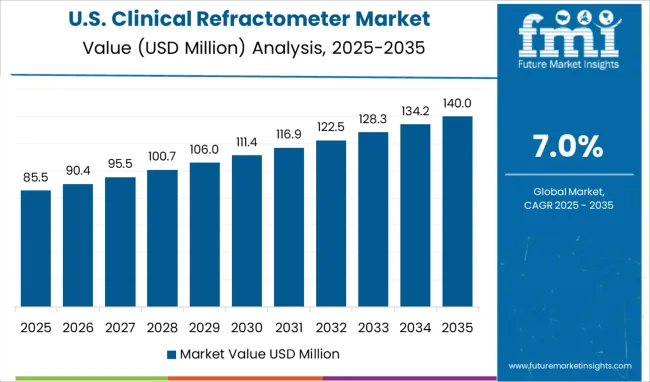
According to Future Market Insights, North America is anticipated to remain the most lucrative market for clinical refractometer through 2025. Demand in the region is increasing owing to the rising adoption of automated testing equipment in various industries.
Expansion of food & beverage and healthcare industries coupled with growing need for accurate testing of food and saline/body fluids will drive the sales in North America. Besides this, availability of these refractometers on online platforms will increase the adoption.
With rapid expansion of healthcare industry, changing eating habits, and increasing demand for automated and digital refractometers, Asia Pacific market will witness highest growth over the forecast period.
Demand for clinical refractometer is surging due to growing popularity of temperature controlled refractometers across food & beverage industry in India and China. End users are more conscious with the quality of food they provide, especially in these countries. Hence, they are adopting digital refractometers to test and provide accurate results for sugar content, alcohol level, and others.
This is projected to drive the demand for digital refractometers in India and China over the forecast period, thereby, boosting the Asia Pacific market.
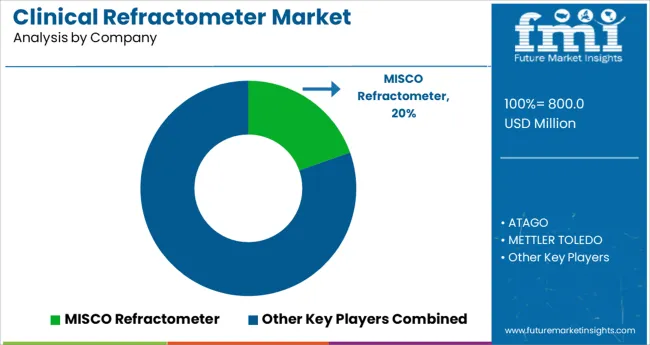
Some of the key participants present in the global clinical refractometer market include Anton Paar GmbH, Thermo Fischer Scientific, AMETEK, Xylem Analytics, Kruss Optronic, Rudolph Research Analytical, ATAGO, Miscro Refractometer, and Shimadzu Corporation among others.
Attributed to the presence of such a high number of key participants, the market is expected to be highly competitive. Key players in the market are focusing on developing advanced and accurate clinical refractometers to cater to the growing demand from healthcare industry.
Some of these players are upgrading their existing products to increase their revenues and gain competitive edge in the industry.
| Report Attribute | Details |
|---|---|
| Base Year for Estimation | 2024 |
| Historical Data | 2020 to 2024 |
| Forecast Period | 2025 to 2035 |
| Quantitative Units | Revenue in billion and CAGR from 2025 to 2035 |
| Report Coverage | Revenue Forecast, Volume Forecast, Company Ranking, Competitive Landscape, Growth Factors, Trends and Pricing Analysis |
| Segments Covered | Product Type, End Use, Region |
| Regions Covered | North America; Latin America; Western Europe; Eastern Europe; APEJ; Japan; Middle East and Africa |
| Key Countries Profiled | USA, Canada, Brazil, Argentina, Germany, UK, France, Spain, Italy, Nordics, BENELUX, Australia & New Zealand, China, India, ASEAN, GCC, South Africa |
| Key Companies Profiled | MISCO Refractometer; ATAGO; METTLER TOLEDO; Thermo Fischer Scientific; Shimadzu Corporation; AMETEK; Rudolph Research Analytics; Cole-Parmer Instrument Company LLC; Xylem Analytical; Others |
| Customization | Available Upon Request |
The global clinical refractometer market is estimated to be valued at USD 800.0 million in 2025.
It is projected to reach USD 1,569.3 million by 2035.
The market is expected to grow at a 7.0% CAGR between 2025 and 2035.
The key product types are analog refractometers, digital handheld refractometer, bench-top refractometers, abbe refractometers and portable refractometers.
academic laboratories segment is expected to dominate with a 42.5% industry share in 2025.






Full Research Suite comprises of:
Market outlook & trends analysis
Interviews & case studies
Strategic recommendations
Vendor profiles & capabilities analysis
5-year forecasts
8 regions and 60+ country-level data splits
Market segment data splits
12 months of continuous data updates
DELIVERED AS:
PDF EXCEL ONLINE
Clinical Trial Biorepository & Archiving Solution Market Size and Share Forecast Outlook 2025 to 2035
Clinical Chairs Market Size and Share Forecast Outlook 2025 to 2035
Clinical Avian Nutrition Market Analysis - Size, Share, and Forecast Outlook 2025 to 2035
Clinical Workflow Solution Market Size and Share Forecast Outlook 2025 to 2035
Clinical Trials Support Software Solutions Market Size and Share Forecast Outlook 2025 to 2035
Clinical Research Organization Market Size and Share Forecast Outlook 2025 to 2035
Clinical Trial Packaging Market Size and Share Forecast Outlook 2025 to 2035
Clinical Mobility Market Size and Share Forecast Outlook 2025 to 2035
Clinical Immunodiagnostics Market Size and Share Forecast Outlook 2025 to 2035
Clinical Communication and Collaboration Market Size and Share Forecast Outlook 2025 to 2035
Clinical Oncology Next-generation Sequencing Market Analysis - Size, Share, and Forecast 2025 to 2035
Clinical Decision Support Systems Market Size and Share Forecast Outlook 2025 to 2035
Clinical Trials Market Analysis - Size, Share, and Forecast 2025 to 2035
Clinical Next-Generation Sequencing (NGS) Data Analysis Market Analysis by Solution and Services, Technology, End User, and Region through 2035
Clinical Hand Hygiene Products Market – Trends, Growth & Forecast 2025 to 2035
The Clinical Alarm Management Market is segmented by component, deployment mode and end user from 2025 to 2035
Clinical Nutrition Market Insights – Trends & Forecast 2025 to 2035
Clinical Diagnostics Market Insights – Size, Share & Forecast 2025 to 2035
Clinical Information System Market Analysis - Growth & Forecast 2024 to 2034
Clinical Chemistry Analyzers Market Trends – Demand & Forecast 2024 to 2034

Thank you!
You will receive an email from our Business Development Manager. Please be sure to check your SPAM/JUNK folder too.
Chat With
MaRIA